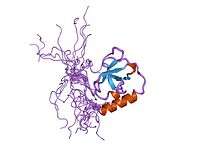Tudor domain
| TUDOR domain | |||||||||
|---|---|---|---|---|---|---|---|---|---|
 Structure of a TUDOR domain. | |||||||||
| Identifiers | |||||||||
| Symbol | TUDOR | ||||||||
| Pfam | PF00567 | ||||||||
| Pfam clan | CL0049 | ||||||||
| InterPro | IPR008191 | ||||||||
| SMART | TUDOR | ||||||||
| PROSITE | PDOC50304 | ||||||||
| SCOP | 3fdr | ||||||||
| SUPERFAMILY | 3fdr | ||||||||
| CDD | cd04508 | ||||||||
| |||||||||
In molecular biology a tudor domain is a conserved protein structural motif originally identified as a region of 50 amino acids found in the Tudor protein encoded in Drosophila. The structurally characterized Tudor domain in human SMN (survival of motor neuron) is a strongly bent anti-parallel β-sheet consisting of five β-strands with a barrel-like fold and recognizes symmetrically dimethylated arginine.[1]
The proteins TP53BP1 (Tumor suppressor p53-binding protein 1) and its fission yeast homolog Crb2[2] and JMJD2A (Jumonji domain containing 2A) contain either tandem or double Tudor domains and recognize methylated histones.[3][4]
Other tudor domain containing proteins include AKAP1 (A-kinase anchor protein 1)[5] and ARID4A (AT rich interactive domain 4A) among others. A well known Tudor domain containing protein is Staphylococcal Nuclease Domain Containing 1 (SND1)/Tudor-SN/p100 co activator.[6] SND1 is involved in RISC complex and interacts with AEG-1 oncogene.[7] SND1 is also acts as an oncogene and plays very important role in HCC and colon cancer.[8] The SND1 tudor domain binds to methylated arginine in the PIWIL1 protein.[9] Tudor containing SND1 promotes tumor angiogenesis in human hepatocellular carcinoma through a novel pathway which involves NF-kappaB and miR-221.[10] Tudor SND1 is also present in the Drosophila melanogaster. [11]
References
- ↑ Sprangers R, Groves MR, Sinning I, Sattler M (March 2003). "High-resolution X-ray and NMR structures of the SMN Tudor domain: conformational variation in the binding site for symmetrically dimethylated arginine residues". J. Mol. Biol. 327 (2): 507–20. doi:10.1016/S0022-2836(03)00148-7. PMID 12628254.
- ↑ Botuyan MV, Lee J, Ward IM, et al. (December 2006). "Structural basis for the methylation state-specific recognition of histone H4-K20 by 53BP1 and Crb2 in DNA repair". Cell. 127 (7): 1361–73. doi:10.1016/j.cell.2006.10.043. PMC 1804291
 . PMID 17190600.
. PMID 17190600. - ↑ Huang Y, Fang J, Bedford MT, Zhang Y, Xu RM (May 2006). "Recognition of histone H3 lysine-4 methylation by the double tudor domain of JMJD2A". Science. 312 (5774): 748–51. doi:10.1126/science.1125162. PMID 16601153.
- ↑ Lee J, Thompson JR, Botuyan MV, Mer G (January 2008). "Distinct binding modes specify the recognition of methylated histones H3K4 and H4K20 by JMJD2A-tudor". Nat. Struct. Mol. Biol. 15 (1): 109–11. doi:10.1038/nsmb1326. PMC 2211384
 . PMID 18084306.
. PMID 18084306. - ↑ Rogne M, Landsverk HB, Van Eynde A, et al. (December 2006). "The KH-Tudor domain of a-kinase anchoring protein 149 mediates RNA-dependent self-association". Biochemistry. 45 (50): 14980–9. doi:10.1021/bi061418y. PMID 17154535.
- ↑ Caudy AA, Ketting RF, Hammond SM, Denli AM, Bathoorn AM, Tops BB, Silva JM, Myers MM, Hannon GJ, Plasterk RH (September 2003). "A micrococcal nuclease homologue in RNAi effector complexes". Nature. 425 (6956): 411–4. doi:10.1038/nature01956. PMID 14508492.
- ↑ Yoo BK, Santhekadur PK, Gredler R, Chen D, Emdad L, Bhutia S, Pannell L, Fisher PB, Sarkar D (2011). "Increased RNA-induced silencing complex (RISC) activity contributes to hepatocellular carcinoma". Hepatology. 53 (5): 1538–48. doi:10.1002/hep.24216. PMC 3081619
 . PMID 21520169.
. PMID 21520169. - ↑ Yoo BK, Emdad L, Lee SG, Su ZZ, Santhekadur P, Chen D, Gredler R, Fisher PB, Sarkar D (April 2011). "Astrocyte elevated gene-1 (AEG-1): A multifunctional regulator of normal and abnormal physiology". Pharmacol. Ther. 130 (1): 1–8. doi:10.1016/j.pharmthera.2011.01.008. PMC 3043119
 . PMID 21256156.
. PMID 21256156. - ↑ Liu K, Chen C, Guo Y, et al. (October 2010). "Structural basis for recognition of arginine methylated Piwi proteins by the extended Tudor domain". Proc. Natl. Acad. Sci. U.S.A. 107 (43): 18398–403. doi:10.1073/pnas.1013106107. PMC 2972943
 . PMID 20937909.
. PMID 20937909. - ↑ Santhekadur PK, Das SK, Gredler R, et al. (April 2012). "Multifunction Protein Staphylococcal Nuclease Domain Containing 1 (SND1) Promotes Tumor Angiogenesis in Human Hepatocellular Carcinoma through Novel Pathway That Involves Nuclear Factor κB and miR-221". J. Biol. Chem. 287 (17): 13952–8. doi:10.1074/jbc.M111.321646. PMC 3340184
 . PMID 22396537.
. PMID 22396537. - ↑ Muying Ying; Dahua Chen (2012). "Tudor domain-containing proteins of Drosophila melanogaster.". Development, Growth & Differentiation.